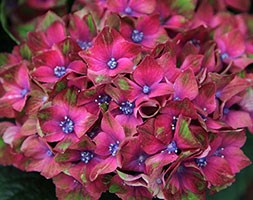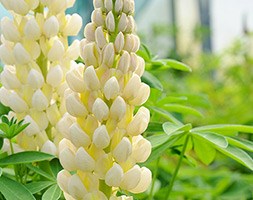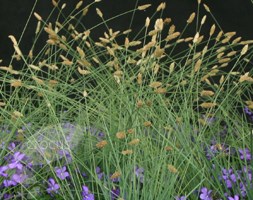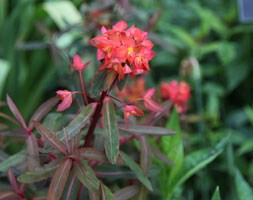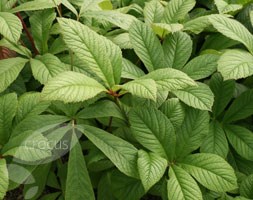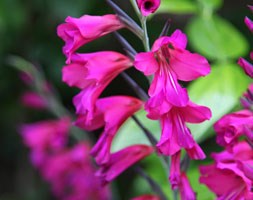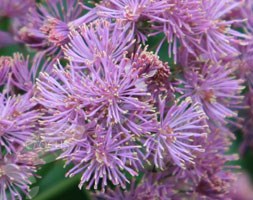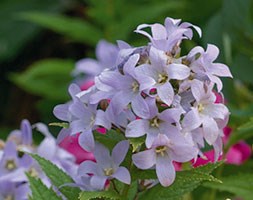New products at Crocus
by Sarah - May 25th, 2014.Filed under: Crocus, New Products.
Crocus has these new products today
Hydrangea macrophylla ‘H20-2’ Miss Saori (PBR) (RHS Chelsea Plant of the Year 2014) £14.99
Position: full sun or partial shade Soil: moist, well-drained, moderately fertile, humus-rich soil Rate of growth: fast-growing Flowering period: June to October Hardiness: fully hardy Winner of RHS Chelsea plant of the year 2014. Garden care: Leave the old flower heads in place through the winter. As the new shoots start to emerge in spring cut back a third to a quarter of the previous seasons flowering stems to the base and cut back the remaining flower heads to the first pair of buds.
Hydrangea macrophylla ‘Schloss Wackerbarth (‘Horwack’) (PBR)’ (hydrangea) £14.99
Position: full sun or partial shade Soil: moist, well-drained, moderately fertile, humus-rich soil Rate of growth: fast-growing Flowering period: June to October Hardiness: fully hardy Garden care: Leave the old flower heads in place through the winter. As the new shoots start to emerge in spring cut back a third to a quarter of the previous seasons flowering stems to the base and cut back the remaining flower heads to the first pair of buds.
Lupinus ‘Cashmere Cream’ (lupin) £9.99
Position: full sun or partial shade Soil: moderately fertile, well-drained, slightly acid, sandy soil Rate of growth: average Flowering period: June to July Other features: the seeds can cause severe discomfort if ingested Hardiness: fully hardy This robust and undemanding perennial produces magnificent spires of creamy white, pea-like flowers, which look beautiful with fresh greens, whites and blues. A star plant in our Chelsea Flower Show garden in 2014, where Luciano Giubbilei used it in drfits throughout the borders. Garden care: Stake with bamboo canes in spring before the flowers appear and deadhead the faded blooms to encourage a second flush of flowers.
Sesleria nitida (nest moor grass) £9.99
Position: grows in both full sun or lightly dappled shade Soil: moderately fertile, well drained, neutral or slightly alkaline Rate of growth: average Flowering period: July to October Hardiness: fully hardy A native of central and southern Italy, this gorgeous little grass is grown mainly for its colourful foliage. It forms dense mounds of pale grey-green to grey-blue leaves, which stay on the plant throughout the year. In spring it throws up whitish green cone-shaped flowerspikes, that bobble about in the breeze. Once established it can be very drought tolerant, and it looks great in a herbaceous or mixed border or wildflower meadow. Garden care: Gently comb through the foliage in spring to remove some of the older foliage and to encourage fresh new growth.
Euphorbia griffithii ‘Dixter’ (spurge) £9.99
Position: partial shade Soil: moist, well-drained garden soil but will tolerate light clay Rate of growth: fast growing Flowering period: June to September Hardiness: fully hardy This deciduous variety, from plantsman Christopher Lloyd’s garden at Great Dixter in East Sussex, has copper-tinted, dark green, lance-shaped leaves with red central veins and rich, brick-red summer flowers that fade to red and yellow in autumn. The flower colour is slightly darker than the better known ‘Fireglow’ and it’s a fabulous spurge for a vibrant planting scheme based on hot colours in a sunny border, or with bronze-tinted ornamental grasses. Given a moist, well-drained soil it may need restricting, since it quickly forms small colonies. It tolerates light clay. Garden care: After flowering remove the faded flower-heads. When working with spurges always wear gloves since the milky sap is poisonous and a potential skin irritant.
Rodgersia aesculifolia (rodgersia) £9.99
Position: full sun or partial shade Soil: humus-rich, moist soil Rate of growth: average Flowering period: July Flower colour: white or pink Other features: large, horse chestnut-like leaves Hardiness: fully hardy Towering spikes of star-shaped, white or pink flowers on large panicles up to 60cm long in midsummer. This striking, clump-forming perennial with its horse chestnut-like leaves looks great planted in the moist margins of a stream or pond. Best grown in a sheltered, shady spot where it contrasts well with the lacy texture of ferns. Garden care: Add lots of well-rotted leaf mould when planting. Protect the young foliage against slug damage using beer traps or environmentally friendly slug pellets. Lift and divide congested colonies in early spring.
Gladiolus italicus (gladiolus byzantinus) £8.99
Position: full sun Soil: moist, well-drained soil Rate of growth: average Flowering period: May to June Hardiness: hardy (borderline) This is an unusual, late-spring flowering bulb which produces spikes of up to 20 funnel-shaped, magenta flowers. It looks stunning planted in groups among shrubs, where it will spread freely, or for providing vivid vertical accents among silver-leaved plants. The exotic-looking flowers also make lovely cut flowers. Garden care: Plant corms 10-16cm (4-6in) deep in autumn, on a bed of sharp sand to aid drainage.
Thalictrum aquilegiifolium ‘Thundercloud’ (meadow rue) £7.99
Position: full sun or lightly dappled shade Soil: moist, humus-rich soil Rate of growth: slow to average Flowering period: June and July Flowers: rich lilac-purple Other features: leaves and flowers are good in flower arrangements Hardiness: fully hardy Beautiful fluffy plumes of rich lilac-purple flowers with dark purple stamens are produced from June and July over attractive columbine-like foliage. The dainty blooms of this early flowering meadow rue provide an excellent contrast with larger flowered plants. Perfect for a border in partial shade, the stems need supporting with brushwoo d or garden canes. Garden care: Divide plants as new growth begins in spring though divisions may be slow to re-establish. In autumn cut back flower stems to the ground.
Campanula lactiflora (milky bellflower) £7.99
Position: full sun or partial shade Soil: fertile, moist, well-drained, neutral to alkaline soil Rate of growth: average to fast-growing Flowering period: July to September Hardiness: fully hardy Tall, branching stems bearing clusters of deep lilac or slate-blue, open, bell-shaped flowers appear from July to September among toothed, mid-green leaves. This tall bellflower is a cottage-garden classic and is perfect towards the back of a mixed or herbaceous border. It’s a happy companion for old roses, self-seeds freely, and the flower colour is retained best in partial shade. Garden care: Protect the tender foliage from slugs and deadhead regularly to prolong flowering and prevent seeding. Apply a generous 5-7cm (2-3in) mulch of well-rotted compost around the base of the plant in spring. Stake with bamboo canes or brushwood in spring before the flowers appear.








